 To say that Kyoto Teramachi Sanjou no Holmes was a niche series would be a pretty massive understatement. At this point I consider LiA to be pretty much a niche anime specialty site anyway, and even here “Holmes” is pretty far out on the fringes of interest. I don’t think too many of you were watching it, but as ever, that’s not a direct indicator of inherent quality or worth. This series may not have been a masterpiece of anything, but there was a lot more to it than met the eye.
To say that Kyoto Teramachi Sanjou no Holmes was a niche series would be a pretty massive understatement. At this point I consider LiA to be pretty much a niche anime specialty site anyway, and even here “Holmes” is pretty far out on the fringes of interest. I don’t think too many of you were watching it, but as ever, that’s not a direct indicator of inherent quality or worth. This series may not have been a masterpiece of anything, but there was a lot more to it than met the eye.
 There was never any question of what we were going to see with the “Holmes” anime – one cour and done, as is the fate of quirky, esoteric outlier series these days. They’re generally based off ongoing series as promoting those is their most relevant commercial raison d’être, and we never get a true ending because of that. In this case the source material is a series of novels (not light) that are as far as I know totally untranslated and will be for all eternity, so that leaves the final episode charged with wrapping things up in a manner which both befits the anime and suggests where the original story might go.
There was never any question of what we were going to see with the “Holmes” anime – one cour and done, as is the fate of quirky, esoteric outlier series these days. They’re generally based off ongoing series as promoting those is their most relevant commercial raison d’être, and we never get a true ending because of that. In this case the source material is a series of novels (not light) that are as far as I know totally untranslated and will be for all eternity, so that leaves the final episode charged with wrapping things up in a manner which both befits the anime and suggests where the original story might go.
 In that regard I don’t think there were any surprises in the finale, but we’ll get to that shortly. It does give us a mystery plot, in doing so introducing more members of Kiyotaka’s extended family. I like that divorced family members don’t just disappear in this mythology, as it gives things a rather realistic air. In this case the extended relatives are Rikyu’s father Saikyo (Fujiwara Keiji), grandfather and uncles – who like everyone else in this social circle are very Kyoto old money (and lots of it). This clan, the Saito, appear to have a samurai history but at the moment, what matters most is the patriarch’s (gorgeous) manor full of antiques.
In that regard I don’t think there were any surprises in the finale, but we’ll get to that shortly. It does give us a mystery plot, in doing so introducing more members of Kiyotaka’s extended family. I like that divorced family members don’t just disappear in this mythology, as it gives things a rather realistic air. In this case the extended relatives are Rikyu’s father Saikyo (Fujiwara Keiji), grandfather and uncles – who like everyone else in this social circle are very Kyoto old money (and lots of it). This clan, the Saito, appear to have a samurai history but at the moment, what matters most is the patriarch’s (gorgeous) manor full of antiques.
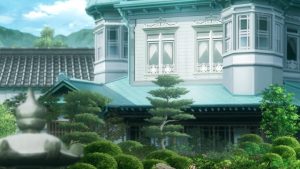 The old man has told his sons to pick an appraiser and come to the mansion for what amounts to a test of their worthiness to be his heir. Rikyu is invited to play too, but clearly isn’t interested in being a part of this strange contest – though he does end up getting paired with Aoi after she proves her worthiness to Rikyu’s grandfather by correcting identifying the makers of a tray full of Raku tea bowls. Also on hand is Enshou, under the alias Tanaka – he’s posed as a connoisseur to get one of Rikyu’s uncles to hire him, mainly for the purpose of annoying Holmes.
The old man has told his sons to pick an appraiser and come to the mansion for what amounts to a test of their worthiness to be his heir. Rikyu is invited to play too, but clearly isn’t interested in being a part of this strange contest – though he does end up getting paired with Aoi after she proves her worthiness to Rikyu’s grandfather by correcting identifying the makers of a tray full of Raku tea bowls. Also on hand is Enshou, under the alias Tanaka – he’s posed as a connoisseur to get one of Rikyu’s uncles to hire him, mainly for the purpose of annoying Holmes.
 Not to be overlooked is the spine of Kyoto Teramachi Sanjou no Holmes, the implied romance. And the complicating factor there is that the other uncle has brought in a museum curator from New York, Keiko, who clearly has a history with Holmes – though not the one she impishly implies to Aoi that she does. The effect is to force Aoi to confront her feelings for Kiyotaka, and she later makes the interesting admission that the reason she split with her boyfriend may have been that she was “too prudish” – which of course is a euphemistic way of saying he wanted to go all the way and she refused.
Not to be overlooked is the spine of Kyoto Teramachi Sanjou no Holmes, the implied romance. And the complicating factor there is that the other uncle has brought in a museum curator from New York, Keiko, who clearly has a history with Holmes – though not the one she impishly implies to Aoi that she does. The effect is to force Aoi to confront her feelings for Kiyotaka, and she later makes the interesting admission that the reason she split with her boyfriend may have been that she was “too prudish” – which of course is a euphemistic way of saying he wanted to go all the way and she refused.
 Forcing Kiyotaka to confront his feelings for Aoi, after a fashion, is Enshou – whose treatment of Aoi-san goes considerably across the line from colorful adversary to outright lowlife. He’s a scumbag for sure, this one, and thank goodness Holmes is (as ever) keeping an eye out for Aoi to make sure she’s all right. But in truth, the most interesting part of all this comes when Holmes angrily muses “If I had his talent…” That’s the moment this plot has been building for from the beginning, in truth – Holmes is both jealous of Enshou’s gifts as an artist (which he doesn’t share and would surely love to), and angry that he chooses to waste them on being a counterfeiter. As for Enshou, he’s too blinded by anger at Kiyotaka for having what he doesn’t to realize what he could have if he would just use his powers for good.
Forcing Kiyotaka to confront his feelings for Aoi, after a fashion, is Enshou – whose treatment of Aoi-san goes considerably across the line from colorful adversary to outright lowlife. He’s a scumbag for sure, this one, and thank goodness Holmes is (as ever) keeping an eye out for Aoi to make sure she’s all right. But in truth, the most interesting part of all this comes when Holmes angrily muses “If I had his talent…” That’s the moment this plot has been building for from the beginning, in truth – Holmes is both jealous of Enshou’s gifts as an artist (which he doesn’t share and would surely love to), and angry that he chooses to waste them on being a counterfeiter. As for Enshou, he’s too blinded by anger at Kiyotaka for having what he doesn’t to realize what he could have if he would just use his powers for good.
 The appraiser/mystery element of the episode ends fairly predictably (though Saikyo’s spectacularly failed play at stealing the contest is quite hilarious), but that leaves enough time for the series to finish on the only ground it can, really. Aoi finally admits the truth – but only to herself. She seems for just a moment as if she’s about to tell Kiyotaka-san but stops herself, though it’s strongly implied that she will eventually. Unlike in many less nuanced anime romances, the reasons for Aoi’s hesitation are quite understandable – Holmes is clearly not a safe option by any means. But there’s an air of inevitability to this that makes the ending feel more or less unambiguous.
The appraiser/mystery element of the episode ends fairly predictably (though Saikyo’s spectacularly failed play at stealing the contest is quite hilarious), but that leaves enough time for the series to finish on the only ground it can, really. Aoi finally admits the truth – but only to herself. She seems for just a moment as if she’s about to tell Kiyotaka-san but stops herself, though it’s strongly implied that she will eventually. Unlike in many less nuanced anime romances, the reasons for Aoi’s hesitation are quite understandable – Holmes is clearly not a safe option by any means. But there’s an air of inevitability to this that makes the ending feel more or less unambiguous.
 One of the elements that makes Kyoto Teramachi Sanjou no Holmes fascinating is definitely that nuance. Kiyotaka is a guy that has an edge to him, make no mistake about it. He may not gave slept with Keiko but I think Enshou is probably right, and Holmes tomcatted around at least his share and maybe more. He’s rich, handsome and incredibly-smart and connected – a bit of a third-rail for a girl like Aoi, four or five years his junior and not possessed of much self-confidence. The thing is, that’s probably a big part of what attracted him to her in the first place – Holmes surely has many young women of his “station” after him, but Aoi is materially different than all of them.
One of the elements that makes Kyoto Teramachi Sanjou no Holmes fascinating is definitely that nuance. Kiyotaka is a guy that has an edge to him, make no mistake about it. He may not gave slept with Keiko but I think Enshou is probably right, and Holmes tomcatted around at least his share and maybe more. He’s rich, handsome and incredibly-smart and connected – a bit of a third-rail for a girl like Aoi, four or five years his junior and not possessed of much self-confidence. The thing is, that’s probably a big part of what attracted him to her in the first place – Holmes surely has many young women of his “station” after him, but Aoi is materially different than all of them.
 Generally speaking I think this series works on all the levels on which it operates. It’s certainly a superb travelogue for Kyoto, and manages within a modest budget to communicate the magic of the place quite effectively. The weekly mysteries are somewhat up-and-down (as is always the case with mystery anime, seemingly) but for the most part do an excellent job of drawing us into the world of collectible art and the eccentrics than frequent it. And of course, that romance – never one to hit the audience over the head, but always simmering away on the back burner, wafts of steam reminding us that it’s there. It’s certainly not for everybody, but Kyoto Teramachi Sanjou no Holmes definitely clicked for me – proof that a good fit is one of the most important elements in enjoying any anime.
Generally speaking I think this series works on all the levels on which it operates. It’s certainly a superb travelogue for Kyoto, and manages within a modest budget to communicate the magic of the place quite effectively. The weekly mysteries are somewhat up-and-down (as is always the case with mystery anime, seemingly) but for the most part do an excellent job of drawing us into the world of collectible art and the eccentrics than frequent it. And of course, that romance – never one to hit the audience over the head, but always simmering away on the back burner, wafts of steam reminding us that it’s there. It’s certainly not for everybody, but Kyoto Teramachi Sanjou no Holmes definitely clicked for me – proof that a good fit is one of the most important elements in enjoying any anime.


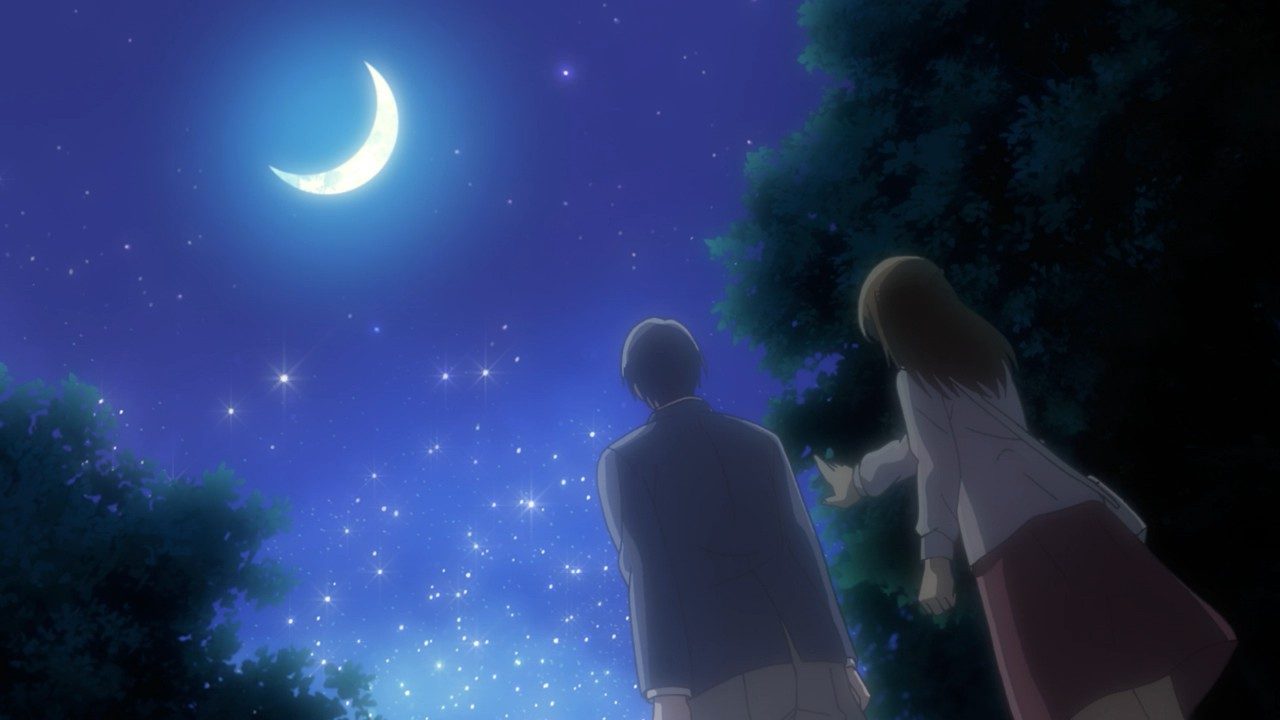





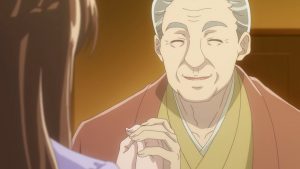

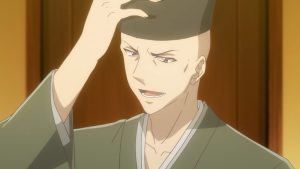


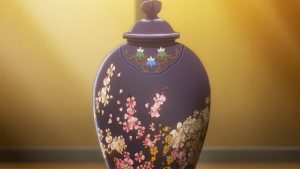





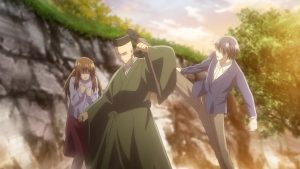







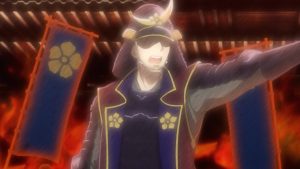



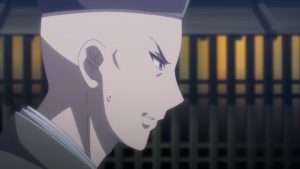
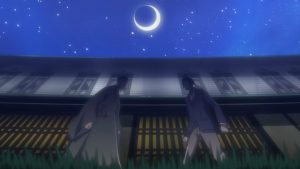








Ayln
September 27, 2018 at 5:36 amI started watching this anime after it was featured in NHK.. which i accidentally saw.. since I don’t turn on the TV often.. so as fate would have it.. hehe.. they said that it depicted Kyoto accurately and beautifully. I completely agree that it’s not a masterpiece but it is interesting and grows on you. Nothing you’d enthusiastically recommend but nice to watch alone.BUT BUT BUT.. I hate these anime’s without endings.. there should be a warning before the 1st episode. Story ongoing or we are just going to **** with you and only so part of the story. Now as no one will transalate the original source you will never know how it all ends *evil laugh*.. seriously.. why do they do this?? Just finished kakuriyo no something and it’s the same thing.. where’s the ending???? Sigh.. I just needed to rant..
Guardian Enzo
September 27, 2018 at 6:45 amI know, believe me. But look at stuff I’ve blogged over the last five years (especially on the year-end “11-20” lists) and it’s littered with them. These adaptations are part of the new normal – these sorts of non-commercial shows get one cour to try and sell source material and that’s it. And they’re too niche for scanlators or English publishers to pick up the source material.
LKK
September 27, 2018 at 10:30 pmThank you for blogging this series, Enzo. The show has been virtually ignored which is a shame. As the season progressed, it became my most anticipated weekly show. After each episode, I eagerly looked forward to reading your take on the episode and to your weekly insight into the Kyoto tidbits they tantalized us with. You did a great public service for us non-Japanese viewers. 🙂
Guardian Enzo
September 27, 2018 at 10:55 pmIt did have a little booth at the Kyoto Anime Manga Fair, which I guess isn’t at all surprising as it’s a good commercial for the city. But yeah, generally pretty much ignored.
Evie
September 28, 2018 at 9:13 amI loved this anime partly because I love Kyoto but I did enjoy the way the story progressed over the weeks. For some reason it reminded me a little of Tsuki ga Kirei, another gem of an anime. Thanks for blogging about this.